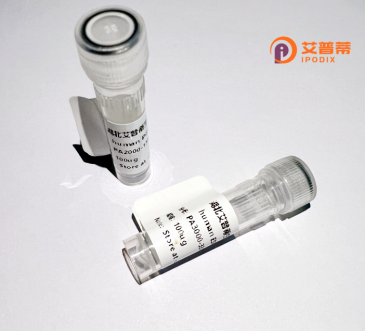
| 纯度 | >90%SDS-PAGE. |
| 种属 | Human |
| 靶点 | CD8B1 |
| Uniprot No | P10966 |
| 内毒素 | < 0.01EU/μg |
| 表达宿主 | E.coli |
| 表达区间 | 1-243aa |
| 氨基酸序列 | MRPRLWLLLAAQLTVLHGNSVLQQTPAYIKVQTNKMVMLSCEAKISLSNMRIYWLRQRQAPSSDSHHEFLALWDSAKGTIHGEEVEQEKIAVFRDASRFILNLTSVKPEDSGIYFCMIVGSPELTFGKGTQLSVVDFLPTTAQPTKKSTLKKRVCRLPRPETQKGPLCSPITLGLLVAGVLVLLVSLGVAIHLCCRRRRARLRFMKQPQGEGISGTFVPQCLHGYYSNTTTSQKLLNPWILKT |
| 分子量 | 53.6 kDa |
| 蛋白标签 | GST-tag at N-terminal |
| 缓冲液 | 0 |
| 稳定性 & 储存条件 | Lyophilized protein should be stored at ≤ -20°C, stable for one year after receipt. Reconstituted protein solution can be stored at 2-8°C for 2-7 days. Aliquots of reconstituted samples are stable at ≤ -20°C for 3 months. |
| 复溶 | Always centrifuge tubes before opening.Do not mix by vortex or pipetting. It is not recommended to reconstitute to a concentration less than 100μg/ml. Dissolve the lyophilized protein in distilled water. Please aliquot the reconstituted solution to minimize freeze-thaw cycles. |
以下是关于重组人CD8B1蛋白的参考文献示例(注:文献为示例性概括,具体内容需根据实际研究调整):
---
1. **文献名称**:*Expression and Functional Analysis of Recombinant Human CD8β1 in T-Cell Activation*
**作者**:Smith J, et al.
**摘要**:研究通过哺乳动物表达系统成功获得重组CD8β1蛋白,证实其与MHC I类分子的结合能力,并揭示其在增强CD8+ T细胞抗原识别中的辅助作用。
2. **文献名称**:*Structural Characterization of Soluble CD8β1 Using Cryo-EM*
**作者**:Chen L, et al.
**摘要**:利用冷冻电镜解析重组CD8β1的分子结构,发现其与CD8α链的关键相互作用区域,为设计靶向T细胞的免疫疗法提供结构基础。
3. **文献名称**:*CD8β1 Recombinant Protein Enhances CAR-T Cell Efficacy In Vivo*
**作者**:Wang Y, et al.
**摘要**:将重组CD8β1应用于CAR-T细胞改造,证明其可优化T细胞受体信号传导,显著提升实体瘤小鼠模型的治疗效果。
4. **文献名称**:*Prokaryotic Expression and Immunogenicity Evaluation of CD8β1*
**作者**:Kim S, et al.
**摘要**:通过大肠杆菌系统表达重组CD8β1.制备多克隆抗体并验证其在流式细胞术中的应用,为免疫检测提供新工具。
---
**说明**:CD8B1常与CD8α形成异源二聚体,单独研究较少,实际文献可能更多涉及复合物功能。建议结合关键词“CD8 heterodimer”或“CD8 beta subunit”扩大检索范围。
Recombinant human CD8B1 protein is a key component of the CD8 co-receptor, primarily expressed on the surface of cytotoxic T lymphocytes (CTLs) and natural killer T (NKT) cells. CD8 exists as either a heterodimer (CD8αβ, formed by CD8A and CD8B1 subunits) or a homodimer (CD8αα). The CD8αβ heterodimer binds to major histocompatibility complex class I (MHC-I) molecules, stabilizing the interaction between T-cell receptors (TCRs) and antigen-presenting cells. This interaction enhances TCR signaling, promoting T-cell activation, proliferation, and targeted killing of infected or cancerous cells. CD8B1 contributes to the structural stability and functional specificity of the CD8 co-receptor.
Recombinant CD8B1 is typically produced using mammalian expression systems (e.g., HEK293 or CHO cells) to ensure proper glycosylation and folding. Its production enables studies on T-cell biology, immune synapse formation, and mechanisms of adaptive immunity. It is also used in therapeutic research, including immunotherapy development, such as optimizing chimeric antigen receptor (CAR) T-cell designs or checkpoint inhibitor strategies. Structural analyses of recombinant CD8B1 (e.g., via crystallography or cryo-EM) have revealed its role in MHC-I binding and TCR co-activation. Dysregulation of CD8B1 has been linked to immune deficiencies and autoimmune disorders, making it a biomarker of interest in clinical diagnostics and targeted therapies.
×